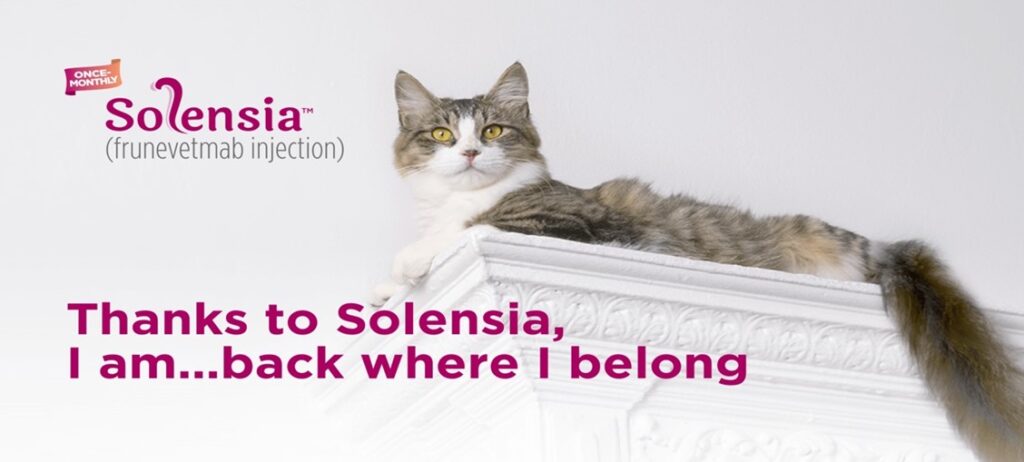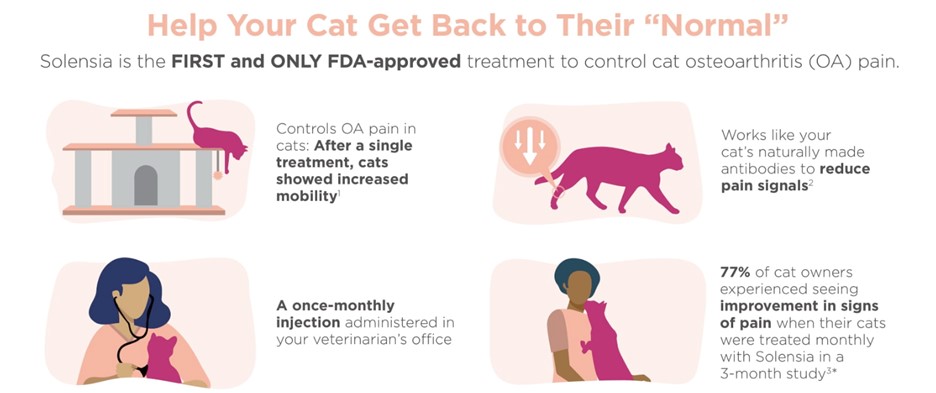What is Feline Osteoarthritis (OA)?
Osteoarthritis is a very common degenerative condition in the joints in cats, where the protective tissue in the joints (cartilage) is worn down and the bones rub against one another causing significant pain and decreased mobility.
It is estimated that 40% of all cats have clinical signs of OA pain. Clinical studies have shown that 60% of cats greater than 6 years of age, and 90% of cats over age 12 have radiographic evidence of osteoarthritis. The condition is not exclusive to older cats however and studies have documented cats as young as 2 years old suffering from OA.
Feline OA pain often goes untreated due to the challenges with giving oral medications to cats. Pilling a cat is not easy! Administering pills can also affect the human-animal bond because it is often traumatic for both parties involved!
OA pain is chronic pain that is always there. It doesn’t go away without treatment and worsens over time. Chronic pain can make it difficult for cats to move around and enjoy their daily activities, leading to a lower quality of life.
How do you recognize your cat has OA or chronic pain?
Cats are masters at hiding signs of pain, particularly while at the veterinary office. Recognizing signs of OA at home in, their natural environment, is crucial for diagnosis and management of chronic pain. Some of those signs may include difficulty jumping up or down, difficulty navigating stairs, difficulty running or chasing objects, difficulty using the litter box, or a reduction in playful behavior and activity. You may also notice a decline in grooming habits (unkempt appearance or overgrown claws due to disuse) or changes to temperament (irritability when picked up, hiding more, or being grumpy towards other household pets).
Watch this video cartoon to learn about 6 SIGNS OF PAIN IN CATS.
Click on the downloadable FELINE OA PAIN CHECKLIST to help you determine if your cat is showing signs of osteoarthritis-related pain.
Treating Feline Osteoarthritis (OA)
In the past, treatment options for OA in cats have been limited. The mainstays of treatment were maintaining a healthy weight or weight loss, acupuncture, and environmental modification to make it easier for cats to get around. Joint supplements have also been used, helping to slow the deterioration of cartilage in the joints, but they do not address the immediate pain associated with OA. Previous pharmacological options for pain management have been limited to:
- Gabapentin, which does not target the specific pain receptors associated with OA
- Meloxicam or Robenacoxib, non- steroidal anti-inflammatory medications (NSAIDs) that are not FDA approved for safe, long-term use in cats
The good news is that we now have an FDA-approved medication for the treatment of OA pain in cats that is safe for long-term use. This treatment option is called Solensia!
Solensia – What exactly is it and how does it work?
Solensia in the first and only FDA-approved monoclonal antibody treatment for control of osteoarthritic pain in cats. Frunevetmab, the active ingredient in Solensia, is a cat-specific monoclonal antibody (a type of protein) designed to recognize and attach to Nerve Growth Factor (NGF), a key mediator of joint pain signaling and inflammation. When frunevetmab binds to NGF, it prevents NGF from binding to its membrane receptor. No binding means no pain response from the neuron and therefore decreased OA pain.
Solensia, is a once monthly injection given subcutaneously (under the skin) by a veterinarian. A noticeable reduction of OA pain can be seen after a single treatment. In a 3-month study, 77% of cat owners experienced seeing improvement in signs of pain when their cats were treated monthly with Solensia.
One of the key benefits of Solensia is its high level of safety. Unlike traditional NSAIDs, Solensia has minimal impact on the liver, kidney and gastrointestinal system, making it safe for cats with gastrointestinal sensitivities, Chronic Kidney Disease, and other illnesses. There have been minimal side effects reported in clinical trials but the most common side effects include: vomiting, diarrhea, injection site pain, scabbing on the head and neck, dermatitis and pruritus (itchy skin). These effects were relatively mild, resolved on their own without treatment and did not require cessation of treatment
Although feline osteoarthritis is not curable, the associated pain can now be effectively and safely managed in most cats. Solensia is a breakthrough treatment option for pet owners looking to improve the quality of life of their cats with osteoarthritis, allowing them to engage in the activities they enjoy with reduced pain. If you have a cat with signs of osteoarthritis, be sure to talk to your veterinarian about the benefits of Solensia.
REFERENCES:
- Gruen ME, Myers JAE, Lascelles BDX. Efficacy and safety of an anti-nerve growth factor antibody (frunevetmab) for the treatment of degenerative joint disease-associated chronic pain in cats: a multisite pilot field study. Front Vet Sci. 2021;8:610028. doi:10.3389/fvets.2021.610028
- Keizer RJ, Huitema AD, Schellens JH, Beijnen JH. Clinical pharmacokinetics of therapeutic monoclonal antibodies. Clin Pharmacokinet. 2010;49(8):493-507. doi:10.2165/11531280\Solensia (frunevetma b injection). Package insert. Zoetis Inc; 2022.
- Zoetis Market Research: KG MarketSense 2018.
- Slingerland L, Hazewinkel H, Meif B, Picavet P, Voorhout G. Cross-sectional study of the prevalence and clinical features of osteoarthritis in 100 cats. Vet J. 2011;187:304-309.
- Hardie EM, Roe SC, Martin FR. Radiographic evidence of degenerative joint disease in geriatric cats: 100 cases (1994-1997). J Am Vet Med Assoc. 2002;220:628-632.
- Lascelles BDX, Brown DC, Conzemius MG, Gill M, Oshinsky ML, Sharkey M. Measurement of chronic pain in companion animals: discussions from the Pain in Animals Workshop (PAW) 2017. Veterinary Journal. 2019;250(8):71-78.




